Menu
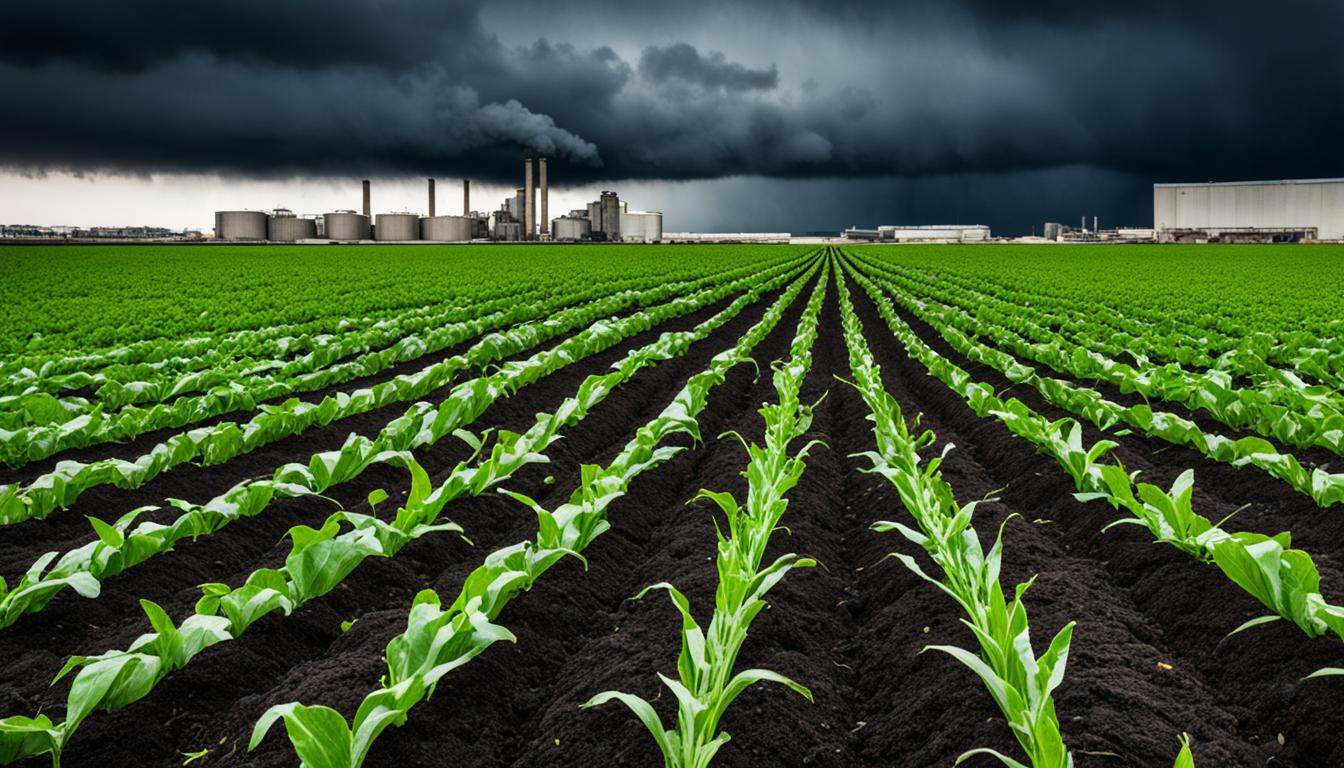
Did you know that over 90% of the world’s food comes from the soil? The effect of policies on farming and country life is huge. These impacts range from new laws to make biogas in New Mexico to changing whole farming methods to help the environment and fight climate change.
In 2024, keep an eye on changes to the farm bill and rules against unfair practices. Also, there might be new rules on H-2A visas. These policy changes are vital, not just paperwork. They keep farms running and help rural areas survive. I’ll explore how policies influence farming, balancing growth with keeping our planet healthy.
There’s also a spotlight on fairness in farming. The 2024 Rural Prosperity and Food Security Act (RPFSA) wants to help the underserved, like people of colour. It plans to keep money for the environment, help local food systems, and make sure everyone has enough to eat. But, Senate Agriculture Committee Republicans need to agree before this act can work.
Equity, nature protection, and helping economies show how policy-making for farming is complex. It’s about adjusting to climate changes, staying financially strong, and using new tech. Soil health is crucial in these plans. It’s key for feeding the world and fighting climate change.
Agricultural policies are key for farmers, shaping how they grow food and how food is bought. In the U.S., there’s a major law called the “Farm Bill” that gets updated every five years. It covers things like farming support, food programs, caring for the land, and making countryside areas better.
In 2018, a big law was passed, also known as the “2018 Farm Act.” It’s all about looking after farms, helping them grow, and staying healthy for the environment. This law comes after the 2014 Farm Bill. It shows how farming goals have changed over time. The Farm Bill doesn’t just make new rules; it can also change old ones or make them last longer.
Every year, the U.S. tells the World Trade Organization how much it spends supporting farms. It also checks in with the OECD to see how these support efforts compare to other countries. Research teams, like those from ERS, look at everything from what we grow to who lives in the countryside to help make policies better.
Knowing the past helps us understand the present when it comes to farming laws. Long ago, the main goal was to make sure there was always enough food and that farming was a good business. As time went on, we began to care more about the planet, making sure farming is fair and doesn’t hurt the earth.
The 2018 Farm Bill marks a big change from the 2014 one, showing new worries and goals in farming. Making these laws often needs a lot of planning and learning. Sometimes, they take longer to start than they should. To fix urgent needs, extra programs can be set up by the government outside of the usual Farm Bill plans.
Many research studies have looked into how farm policies affect the land, jobs, farm profits, and how well farms work. This info is crucial for improving future policies.
| Aspect | Details |
|---|---|
| Legislative Cycle | 5-year Farm Bill |
| Key Policies | Commodity programs, conservation, crop insurance |
| Global Participation | WTO reporting, OECD PSE monitoring |
| Research Contributions | ERS studies, 103 article reviews |
| Main Challenges | Policy implementation delays, unforeseen events |
Monetary policy is key in how the countryside runs. It mainly controls interest rates, exchange rates, and inflation. These affect farming in many ways, from getting loans to selling abroad and costs of making goods.
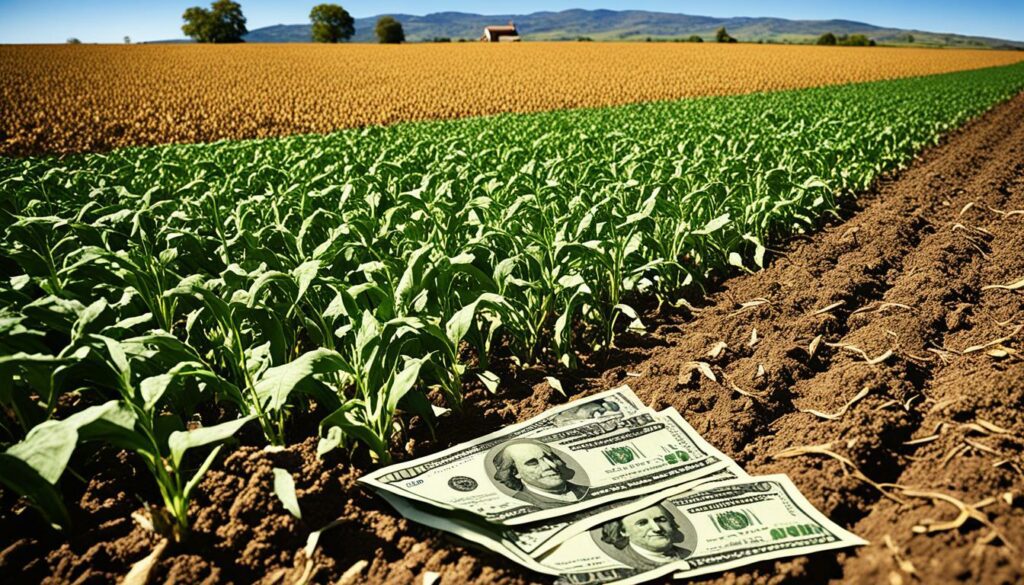
The effect of monetary policy on agriculture reflects in how loan rates change things. High farm credit interest rates stop farmers from borrowing money for seeds and machinery. Steep rates in the 1980s led to a farm loan problem, showing big problems can arise.
The USDA predicts 91 million acres of soybeans and 89.5 million acres of corn to be planted in the U.S. in 2022. Yet, corn planting plans are down by 4%, the lowest in five years. This makes the need for low loan rates clear.
| Crop | 2022 Projection (Million Acres) | 2021 Comparison |
|---|---|---|
| Soybeans | 91 | +4% |
| Corn | 89.5 | -4% |
| Wheat | 46.6 | +1% |
Changes in exchange rates also matter in monetary policy’s effect on agriculture. When other countries’ money loses value, it’s harder to sell U.S. goods abroad. This affects sales of important crops like corn and wheat.
Russia and Ukraine make up a big part of the world’s wheat sales – about 29%. Their currencies changing can really shake up the market. So, keeping exchange rates fair is key to keeping up sales.
Inflation’s also a big deal for farmers. It makes items like seeds and feed more pricey, cutting into profits. With the U.S. seeing its highest inflation in 40 years, it’s crucial to control costs.
High input costs and inflation can hit farm incomes hard. It can also push food prices up worldwide. With global issues, food and feed prices could rise by up to 22%. This makes fighting inflation urgent.
Good monetary policy helps farmers by keeping loan rates low and export sales strong. It also helps them handle rising costs better.
Governmental agricultural policies are key in the farming industry. They lay out rules at the federal and state levels. The United States Department of Agriculture (USDA) is a main player in putting these rules into action. They focus on making sure we have enough to eat, helping farmers earn, and pushing for green farming ways.
Rules at both the national and state levels keep farming in order. They cover things like helping farmers insure their crops and looking after the land. The Farm Bill is very important. It was last updated in 2018 and tackles things like making rural areas better, trade, and making sure people eat well.
Helping out with cash and tax breaks is crucial for farms to make money and work better. Over 20 years, studies found that this help really does boost what farmers can do and how much they earn. However, what kind of help works best can change depending on the study.
With rules and help, government agencies agriculture aim to meet the many needs of farming. This helps make sure farming is good for the environment and the economy.
The 2024 Farm Bill, or the Rural Prosperity and Food Security Act, is crucial for farming. It covers many topics key for the future of agriculture and rural areas.
The 2024 Farm Bill provisions heavily focus on nutrition programs. It’s expected that these will take up over 80% of the bill’s budget. This equals more than $1.2 trillion over the next decade. One big change is that SNAP funding has almost doubled from $65 billion in 2018 to about $127 billion in 2023. The USDA changed the Thrifty Food Plan, which caused SNAP benefits to jump by 25%, their largest increase ever.
Chairman Thompson wants to cut future SNAP spending by $30 billion without harming current users. He’s looking for a way to balance saving money and still helping those in need.
The Rural Prosperity and Food Security Act highlights actions for climate-smart farming. This is backed by $19.5 billion from the Inflation Reduction Act. Some Republicans don’t fully support this climate program. Their main issue is that it doesn’t provide enough for farmers with different needs. On the other side, farmers want higher prices set for crops. This would mean they get more help with their costs.
Looking ahead, the Congressional Budget Office shows that predicting future crop costs is tough. This affects guesses on how much the farm bill changes might raise costs. Still, Thompson believes there are ways to support farm safety nets fully without taking money from IRA or SNAP.
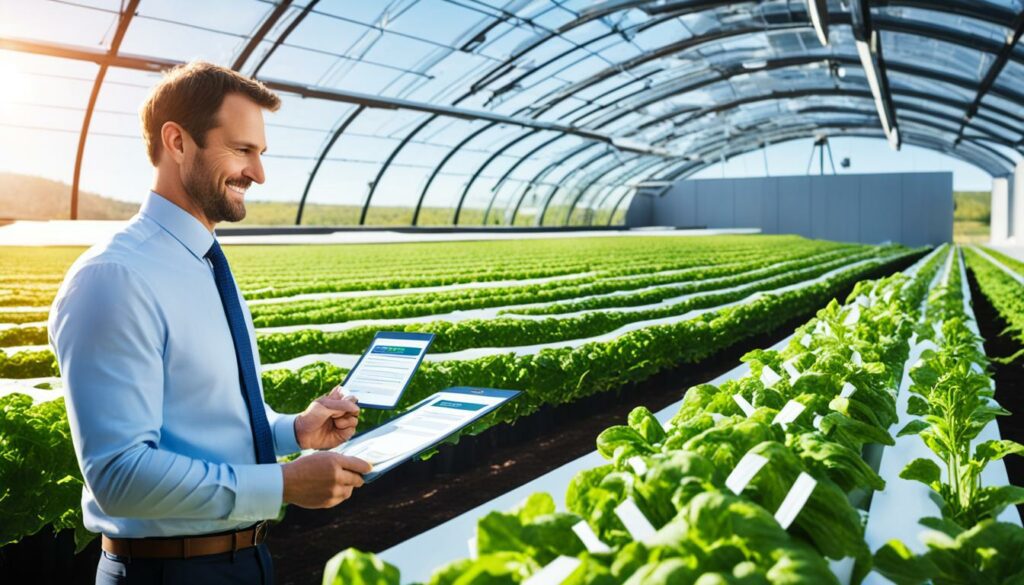
| Factor | 2018 | 2023 | Future Estimate |
|---|---|---|---|
| SNAP Funding | $65 billion | $127 billion | Projected stable |
| Climate-Smart Agriculture Initiatives | N/A | $19.5 billion | Continued investment |
| Nutrition Programs | $960 billion (over 10 years) | $1.2 trillion (over 10 years) | Upward adjustments |
Agricultural policy changes affect the economy of farming greatly. They influence how markets move and how secure farmers are financially. These policies are key for market stability and helping farmers keep their income.
Changes in agricultural policies greatly impact market stability in farming. These policies work to make prices less unpredictable. But, things like global trade and the changing climate also have a big effect.
For example, more land was insured to help farmers during uncertain times. This insurance doubled by 1994 and by 2000, it covered 60% of the USA’s crop fields. This helped keep commodity prices stable, giving farmers a safety net.
Ensuring farmers stay financially stable is a top goal in agriculture. The CRP in 2005 paid farmers not to use their land. This covered an area almost as big as Iowa. It aimed to keep farming balanced and farmers financially sound.
Yet, farmer debt remains a big issue. In 1997, changes in crop insurance led to more land being farmed. A third of this new farmland was at risk of erosion. This situation has led to cycles of debt and instability for farmers.
| Year | Insured Acreage (Million Acres) | Impact |
|---|---|---|
| 1982-1997 | Below Average Soil Productivity | Significant Shifts in Cultivation |
| 1990-1994 | 90 to 197 | Insurance Doubled, Increased Stability |
| 2000-2003 | 212 (Avg) | 60% of Cropland Insured |
| 2005 | CRP Implementation | $1.7 Billion, Land Conservation |

Weather patterns are getting more erratic, with 100-year floods, long droughts, and heat waves becoming common. These conditions are a danger to farmers, their crops, and animals. It’s clear we need strong climate change policies in agriculture to protect these from harm.
There are essential ways to fight climate change’s effects on farming. Practices like agroforestry and growing perennial pastures are proven to make farms stronger and cut down on greenhouse gases. The National Sustainable Agriculture Coalition highlights the need for these methods in wider sustainable farming efforts.
Reducing greenhouse gases is a top priority for sustainable farming. The NSAC says farming needs both new technologies and a more natural, whole-farm approach. By following agroecological principles, the agriculture sector can fight climate challenges and stay productive.
Funding for climate-smart farming is a must. Rising temperatures bring new crop diseases and pests, threatening food supplies. Public and government aid is essential for farming that is good for the environment and the people it feeds. Financial bonuses for lowering emissions are also becoming more popular.
| Initiative | Description |
|---|---|
| Agroforestry Systems | Integrating trees and shrubs into crop and livestock systems to enhance biodiversity and reduce greenhouse gases. |
| Perennial Pastures | Utilising perennial plants in grazing systems to improve soil health and carbon sequestration. |
| Carbon Markets | Providing financial incentives for farmers to adopt practices that reduce carbon emissions. |
Achieving social and racial equity in farming is vital for a fair agricultural sector. There are still significant challenges from past injustices that need tackling. It’s important to make sure everyone can access land, funds, and resources in farming.
The USDA has set up an Equity Commission to work on this. This group focuses on fixing issues like racial and economic gaps. They use acts like the Inflation Reduction Act to help those in need, such as providing help with debts from loans.
It’s also suggested to increase the funding for certain farming programs to 30% for farmers just starting or who face social disadvantages. This would help many farming communities by giving them more money and making it easier to get professional advice.
To ensure fair treatment, it’s recommended that more money is set aside for programs benefiting farmers who face challenges, including those of colour. Also, providing USDA information in different languages would help many people join these programs.
A special Navigator Programme is a key idea. It would help underserved farmers learn about and access these support programs. Using better data collection on who gets this help will also make sure things are fair and transparent.
Many underserved farming communities struggle, with most farm jobs offered by fewer than 50,000 farms. To help, making professional advice more available and easier to get is crucial.
It’s vital to also direct more funds to support farmers who face social and racial challenges. This way, they won’t face too much paperwork when asking for help. These steps are designed to make sure the farming world is more welcoming and fair.
| Statistical Data | Value |
|---|---|
| White food workers’ average annual income | USD 25,024 |
| Workers of color’s average annual income | USD 19,349 |
| Percentage of farms hiring over 90% of all farm workers | Less than 50,000 |
| Percentage of farm workers born outside the United States | 70% |
| Black-owned farmland loss over the past century | 90% |
| Percentage of Black-owned rural land in the U.S. | Less than 1% |
Investing in research and development (R&D) is key for growing agricultural technology innovations. These investments are setting the stage for new farming methods. They aim to boost productivity, be friendlier to the environment, and make farming more efficient. There’s a big move towards using new technologies, thanks to good farming policies, to feed the world and solve tough farming issues.
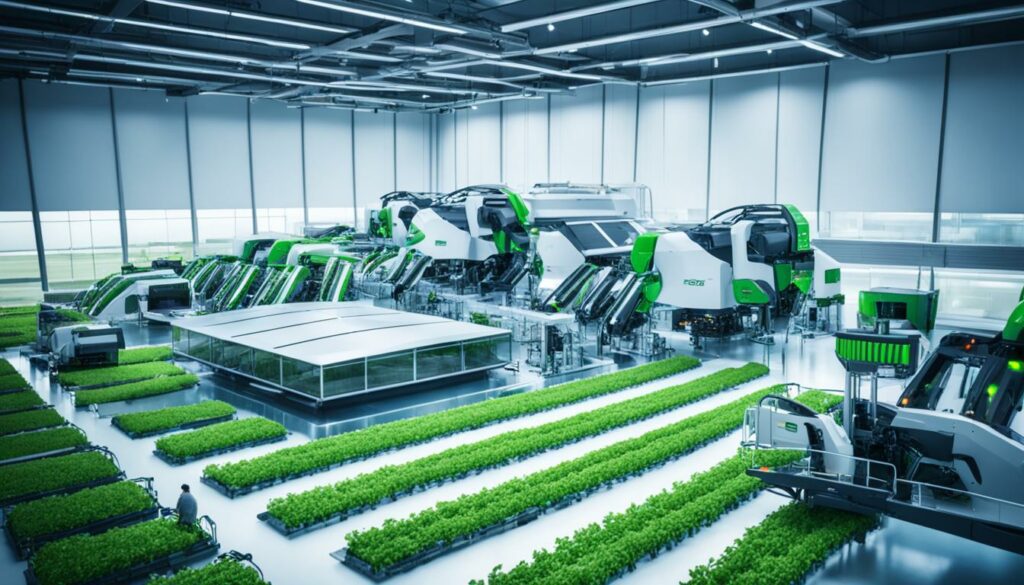
Our need for food is set to jump by 70% by 2050 because there will be more people. To keep up, we must invest a lot in developing farm methods through R&D. Richer countries spend about 3.25% of their farm money on this, while poorer countries only spend 0.52%. This big difference shows we need better policies everywhere to help come up with new solutions that fight hunger and keep farms healthy. Companies, besides governments, also play a huge part in funding this work. Their contributions show we need everyone to pitch in towards these goals.
There are new ways to farm that boost what we can grow and save our resources too. An example is indoor farming, which can yield between three to six tonnes of rice per hectare. This is much more than traditional ways. Farm tools that work on their own, like harvesters and drones, help save time and make the best use of what we have. There’s also GPS-like technology that guides exactly where to plant or plough. This lowers mistakes and helps the soil stay healthy.
Improving how we use water on farms is important too. New tech in watering means less waste and more sustainable use of water. Another cool tech is about making plants better but not by changing their genes. This can increase our harvests by 23% without needing as many chemicals. The market for high-tech farming is growing fast. It’s expected to be worth $16.35 billion by 2028. This shows how much we need and want these new tools for farming well.
| Technology | Key Benefits |
|---|---|
| Indoor Vertical Farming | Increased yield: 3-6 tonnes per hectare |
| Farm Automation | Reduced labour time, enhanced yields |
| RTK Technology | Centimetre-level accuracy, reduced soil compaction |
| Minichromosome Technology | Enhanced crops by 23%, reduced chemical use |
To sum up, supporting policies and funding tech innovations in agriculture can make our farms more efficient. By adopting new farming practices and strong R&D policies, the agriculture industry is on the brink of positive change. These efforts will help us overcome current and future farming challenges.
Rural policies don’t just affect farming. They also change the economy and social life in local areas. These policies bring big changes, like creating jobs, holding communities together, and protecting local traditions.
In the 1950s, many rural folks worked on farms. By the present day, far fewer do. Nevertheless, around the 1990s, rural places saw more people again. This shows how policies can boost local economies and bring in new trends.
The late 1900s saw less poverty and more jobs in rural areas. But, since 2000, many factory jobs have gone, showing that rural economies can be fragile.
These policies change the people living in rural areas. For instance, more rural Hispanics live outside the southwest now. This is influenced by certain policies. These create a more united and lively community.
Certain initiatives help poor families get better food and connect rural areas to the internet and phones. This makes life better for many people. It’s part of efforts to keep rural areas strong and connected.
Rural policies are crucial for community growth and unity. They must consider both the economy and cultural life. This is key to keeping rural places thriving and resilient.
| Year | Development Indicator | Percentage |
|---|---|---|
| 1950 | Rural Population on Farms | 40% |
| 1990s | Population Growth | 10% |
| 2000 | Poverty Rate | 13.4% |
| 2000 | Nonmetro Unemployment Rate | 4.4% |
| 1950-2000 | Jobs Lost in Manufacturing | -2.6 million |
The way we regulate commodities and insure crops is vital for farming to stay afloat. This is key because markets are up and down, and natural disasters can always happen. In the U.S., every five years, a new Farm Bill shapes how farmers are protected. The latest Farm Bill from 2018 places extra focus on helping farmers with things like commodity and crop insurance.
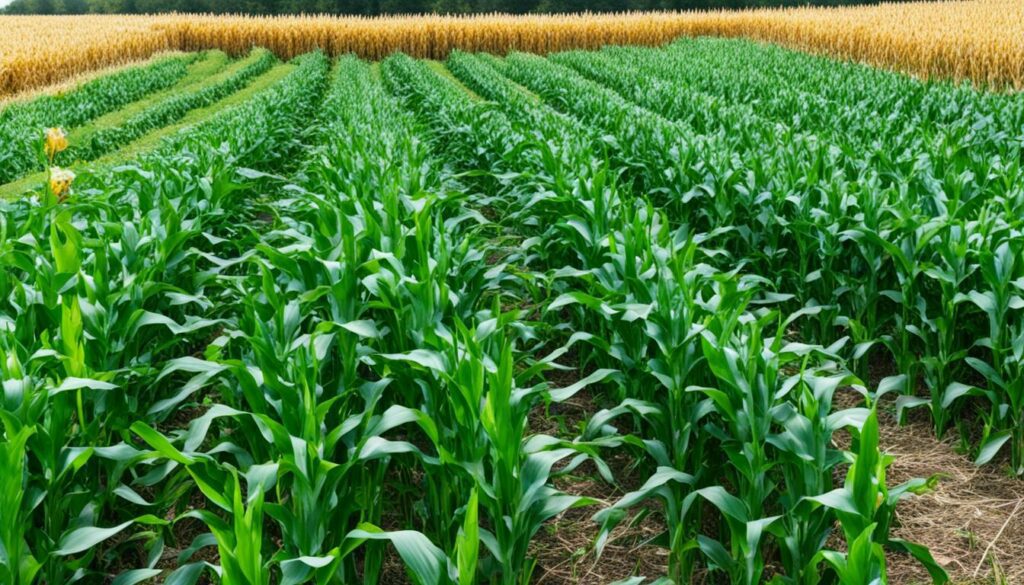
Crop insurance is a farmer’s safety net against low yields or market problems. The Federal Crop Insurance Program (FCIP) is key here. It helped protect an average of 284 million acres each year between 2000 and 2021. This system has become more popular, with acreage jumping from 206 million in 2000 to 444 million in 2021. In that same year, an impressive 74% of all crops were covered by insurance.
These policies offer different levels of protection. Farmers can insure a part of their crop value or safeguard against dangers like bad weather. The Catastrophic Coverage plan (CAT plan) ensures indemnity payments if yields are less than half of what was expected. This system is working well, as shown by a low 0.86 loss ratio in 2023. This means the money farmers and the government put in for insurance matched well with what was paid out for losses.
There are plans to make crop insurance even better. The Congressional Budget Office expects the 2024 crop insurance cost to be as high as $12.37 billion. To meet this demand, bodies like the Federal Crop Insurance Corporation (FCIC) plan to introduce new policies. They’ll do this by taking in advice from different people through a 508(h) submission process.
The coming changes will also show extra support for new and skilled farmers. They plan to give these farmers a 10% extra discount to make things fairer. This is all about ensuring that what farmers pay in premiums matches well with the support they get over the years. This approach helps create strong support for all farmers. As time goes on, we’re working to make commodity rules and crop insurance policies even better.
The US Department of Agriculture (USDA) is key in shaping agricul’tural p’olicy. It affects how we farm, our countryside economies, and the health of our land. Making rules that help farmers and protect the envir’onment is tricky.
Reaching a balance between making money and keeping our earth healthy is crucial. The Farm Bill, a vital US ag’ricultural law, gives a lot of money to farmers. It supports them through crop insurance, creating nature-friendly farming, and feeding the public.
However, some of these helps push farmers to grow one crop only. This can harm the land. Working to mix making a living with taking care of the earth is needed. It’s key for a long-lasting farming future.
Some policies can bring good, like the SNAP food program lifting many from poverty. But, other rules might create uneven earnings and waste resources. For example, growing corn in big fields costs the public a lot because of water pollution.
Helping farmers based on their income rather than what they grow could solve some issues. This change can spark new ideas and stop problems in the markets. It’s important that rules keep up with new tech and ways of thinking to deal with challenges ahe’ad.
| Agency | Role | Impact |
|---|---|---|
| USDA | Policy-making and support | Influences farming practices, economic stability |
| FCIP | Crop insurance | Affects crop selection, environmental impact |
| SNAP | Nutrition assistance | Reduces poverty, supports vulnerable groups |
In the end, figh’ting ag’ricultural p’olicy humps needs br’ave and smart moves. We must think hard about how p’olicies affect people and our planet. This way, we can build a farming scene that bounces back, treats everyone fair, and cares for our environment.
Current farming laws are always changing. This shows how farming itself is always moving forward. The U.S. Department of Agriculture (USDA) has noted many updates for 2022. These changes aim to tackle today’s farming challenges.

Farms have seen big changes due to new laws. These include updates to farm programs. They also feature new plans for when disasters like COVID-19 hit. Programs to help farmers switch to organic have also grown.
The U.S. is now pushing for greener farming. Practices that help the climate are getting more attention. This covers not just the U.S., but also global efforts. The U.S. is also focusing on hunger and better nutrition.
The future of farming policies looks green. This means more concern about the Earth and farming together. There will be more help for farmers to use land wisely. And, support will keep being fair for all.
Future laws will focus on things hit by COVID-19. These include making sure food chains are strong. Also, they want to help small and new farms succeed. A big law, the Farm Bill, will keep working towards these goals.
The table below shows what’s happened and what’s to come:
| Legislative Changes | Future Projections |
|---|---|
| Introduction of Climate-Smart Commodity Partnerships | Expansion of Climate Resilience Programs |
| Adjustments to Crop Insurance and Credit Programs | Further Development in USDA Conservation Efforts |
| Temporary Assistance Programs Due to Pandemic | Emphasis on Rural Broadband Deployment |
| Equity-Focused Initiatives and USDA Organic Regulations | Support for Small and Disadvantaged Farmers |
To sum up, keeping up with farming laws is vital. It helps everyone in the farming community. By staying informed, we can help shape a better future for farming.
Between 1994 and 2012, the amount of farmers markets in the U.S. shot up from 1,700 to more than 7,800. This rise highlights the growing interest in local food policies. It shows how rules supporting community food making and sharing are crucial.
Over 12,400 schools in all 50 states are in farm-to-school schemes. They’ve made over $13 million in sales for local farmers. These schemes are key in making good food choices and teaching kids about farming.
In many places, food policy councils are working hard to connect farming actions better. They play a big part in solving local food problems and making rules that are good for everyone.
Groups like the Chefs Collaborative are working to get more local, sustainable food into dining places. These efforts are vital for healthy economies and spaces.
Places without easy access to fresh food are starting community gardens more and more. These not only offer healthy food but also bring people together. Good rules help these gardens grow well.
While many local areas don’t focus only on food, food policy councils help. They bring everyone together to make local food rules for all steps, from growing to throwing away.
Change Lab Solutions and other groups support building strong local food policies. Their help makes sure the rules are good and really support local farmers and communities.
The Union of Concerned Scientists looks into how policy changes can affect the economy. They highlight how important it is to have local food rules that can change with the times. USDA-funded projects aim to make fair and earth-friendly food systems.
More people want to buy local food, especially from small farms. This increase in direct sales shows the economic power of local food. Programmes like GusNIP have a big impact, bringing in $85 million in a year.
Different funding is there to help with food waste, extreme weather effects, and how tech can help in farming. Programs like OREI and SARE are important for spreading good farming methods.
Lastly, the Farm to School Grant Program helps schools offer local food. The FINI Program makes buying fruits and veggies easier. Both aim to make food healthier and more available.
Looking into conservation funding’s role shows how closely money and taking care of our planet are tied. The Farm Bill’s renewal highlights the vital role of certain programs. These programs help choose where money goes for fighting climate change.
The 2023 Farm Bill renewal will affect how funds help cut farm emissions. This will help profits and reduce harm to the environment. Small and new farmers, plus some groups, will get extra help through specific conservation programs.
Some big farmers have got a lot of the conservation money in the past. The Farm Bill renewal wants to change this. It aims to make applying for help easier and tie conservation efforts to getting crop insurance. This would encourage farmers to be more environment-friendly.
Cover crops are promising in reducing insurance claims for not planting. But this needs more study. The 2023 renewal will decide where more focus and money should go. It could be on improving water, soil, protecting wildlife, or cutting greenhouse gases.
The House Agriculture Committee’s Farm Bill draft has sparked a concern. It wants to take away some climate-protection rules from the Inflation Reduction Act. This act helps farmers use methods that produce more food, save money, and fight bad weather. Without these rules, American farming’s future could be at risk.
Making wise choices with climate finance and farming funds is critical. It helps farmers face the tough environment better. This way, we ensure farming’s future is safer and more sustainable.
This part combines findings from previous studies. It gives us a full picture of how policies influence farming’s results. The main article, “Policy Impacts on Farming: A Deep Dive Analysis,” had 187k reads and referred to 53 sources. This farming policy comprehensive analysis looks into various complex topics using insights from 103 articles.
For example, 54 studies looked at how policies affected farm product quantities. 25 studies deep-dived into deciding where to grow what, looking at different crops and expanding farm sizes. The focus on making farming more efficient came from 23 studies.

In addition, 18 studies checked how policies affect who works on farms and elsewhere. Another 17 studies focused on how farming policies influence agriculture policy implications on income. These looked at how things like help with buying supplies, selling crops, and technical advice affected money made.
Cash, loans, and tax breaks were common areas of study. While some research concluded that financial help raised farm production, some found no effect. Out of 154 papers reviewed at first, only 37 were included in the final analysis.
A move to using more advanced tools for policy assessment was noted, like using AI and models. But not many studies looked at how to judge these policies on farms effectively.
It’s vital to see how farm policies impact the environment. Policies were grouped based on their main goals to stress the importance of checking these policies for a sustainable farming future.
| Category | Number of Studies |
|---|---|
| Impact on Agricultural Production | 54 |
| Land Allocation | 25 |
| Efficiency | 23 |
| Employment Rates | 18 |
| Farm Income | 17 |
This work underlines the need for strong approaches to evaluate new policy effects. I stress that farming policies and their results are deeply connected. This calls for careful policy-making.
The study of agricultural policies shows how they shape farming. We looked at 103 articles. These articles showed that government policies really change farming. They change what’s produced, where land is used, how well farms work, who gets jobs, and how much money farms make.
Financial help like subsidies, loans, and tax breaks is key. But, not all studies agreed on the impact. Some saw more produce; others saw little change. Still, different kinds of support have helped farms grow and make more money in many cases.
The world’s farming is also affected by food and tobacco rules. These rules help reduce the use of unhealthy stuff. About 40% of maize worldwide comes from the United States. This is thanks to big government help. Helping tobacco farmers find other ways to earn a living is also vital for health.
Helping places with not enough food is crucial. Problems with farming can make life hard for people who move because of these issues. But, good weather and enough seeds to plant can fight these problems a bit. This is shown by FAOSTAT’s data on land and crops.
In the end, we see that farming policies are very complex. They mix money issues with protecting the environment and social needs. A close look at everything helps us make policies that help farms last long and be strong.
Agricultural policies include rules and schemes by governments. This involves things like subsidies to help farmers. Efforts are made to encourage sustainable farming and make sure there is enough food for everyone. The USDA helps a lot with these policies, affecting how much money farms make and how they run.
Agricultural rules have changed because of money and politics. These changes show how farming methods and rural economies have grown. Looking at this history helps us understand today’s farming laws better.
Monetary policy changes farming through three key areas: interest rates, money exchange rates, and inflation. High interest rates can mean less money for farmers to buy what they need. Changes in exchange rates affect how well farmers can sell their goods abroad. If prices go up because of inflation, this can cut into profits.
The USDA helps make and enforce farm rules at the national level. It is key in giving out money, like grants and aid. Its work aims to make sure farming is done in a way that’s good for the Earth and keeps everyone fed.
The 2024 Farm Bill is all about helping farms and making sure there’s enough food. It focuses on things like saving the environment, smart farming to deal with climate change, helping farms get money, and encouraging local food systems. These points aim to make farming better for everyone and the Earth.
Rules can change how much farmers get paid and how much their goods cost. By looking at these factors, we see how farm laws and the economy work together. This view helps keep the farm sector strong.
Policies today are all about protecting the Earth while still producing food. They involve things like saving energy and reducing gases that harm the planet. The goal is to farm in a way that doesn’t hurt the environment.
Rules focus on making sure everyone has a fair chance at farming. This includes equal chances to get land, money, and help. The goal is to right past wrongs and make sure everyone has a say in farming.
Investing in new farming technology helps farms be more efficient and kind to the environment. It’s essential for farms to grow and change for the better. Policies that support new ways of farming are very important.
Rules for countryside areas can help create jobs, bring people together, and keep traditions alive. These efforts don’t just affect farms; they also shape the life and economy of the whole area.
Insurance plans are there to help farmers when things go wrong in the market or with the weather. The current and future systems are getting more support to make sure farmers can bounce back from hard times.
Creating farm rules means finding a good balance between making money and looking after the Earth. This process is about facing problems and finding ways to make farming better without harming the planet.
Recent laws and future changes show that farm rules always need to adapt. Knowing these trends helps plan for the future of farming. People involved in farming need to keep up with new regulations.
The rules that support local food help the economy, make sure there’s enough food, and keep farming traditions going. By backing local food, these policies make farming stronger and more sustainable.
Money for protecting the Earth and fighting climate change is very important for farming. Both the government and private groups help fund these efforts. This support is crucial for a farm-friendly, green future.
Understanding the full effect of farm rules shows how everything is connected. Good policy-making is needed to help farming grow in a way that’s good for the Earth and people.